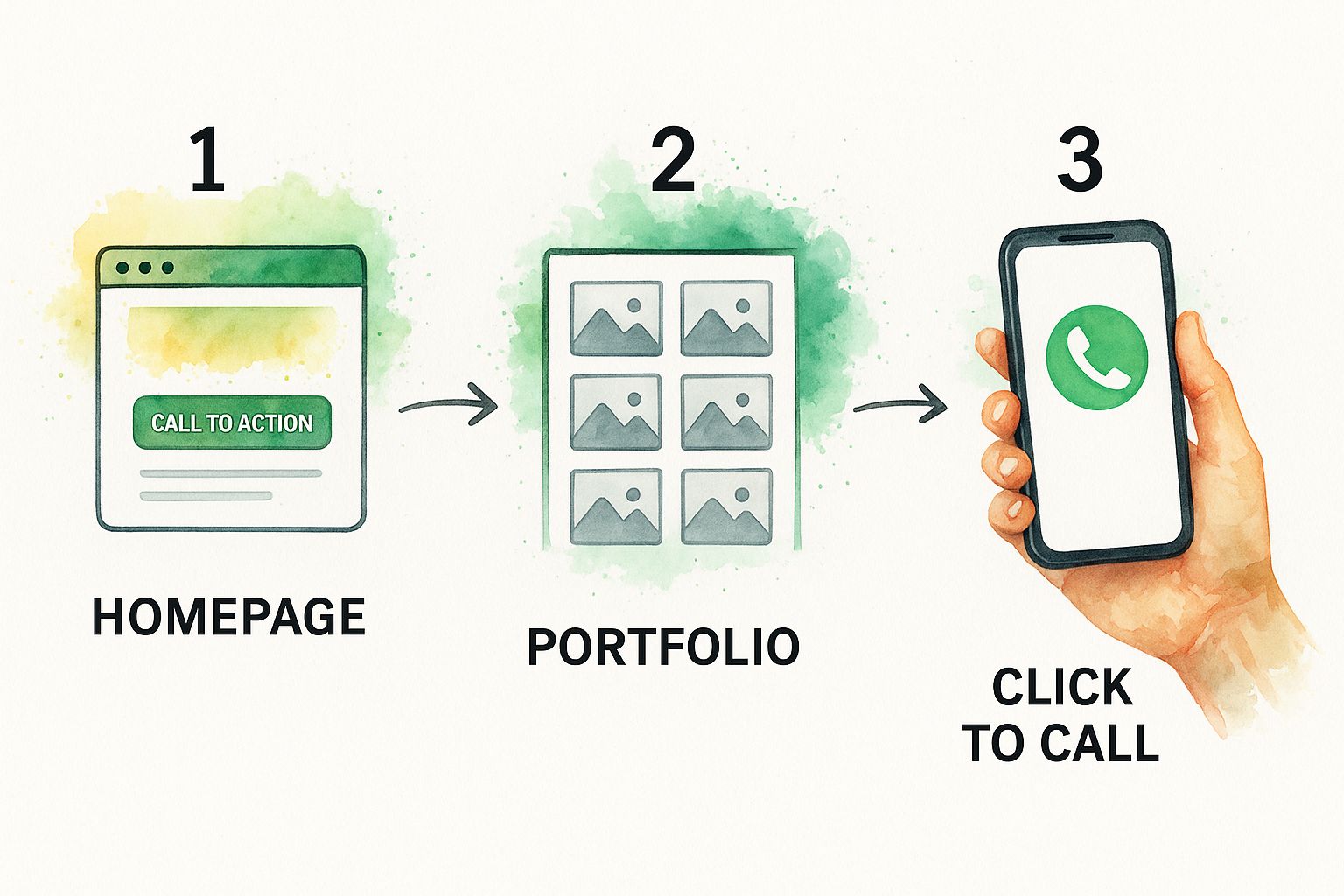Web Design for Tradies: The Ultimate Guide for Small Businesses
Grow your business with our guide to web design for tradies. Learn how to build a website that wins more jobs and builds trust with local Australian customers.
Look, let's get straight to it. Relying solely on a Facebook page for your trade business is like having a market stall but no actual shop. You're definitely leaving money on the table. A dedicated website is your most powerful asset for building the kind of solid credibility and trust that social media just can't deliver. It's your permanent, 24/7 digital shopfront where you're in complete control of the conversation, helping you win more local jobs.
Your Website Is Your Best Salesperson

Think about it this way: your website is your hardest-working employee. It never sleeps, never calls in sick, and is always ready to make a great first impression on a potential customer in your local area. Social media is fine for a few updates here and there, but a professional website gives you a polished, permanent space to properly showcase your best work, explain your services, and—most importantly—capture leads directly.
Having a strong online presence isn't just for the big corporate players anymore. For a local sparkie in Geelong or a plumber out in Perth, a well-built website can single-handedly drive growth. It's what separates "that guy with a ute" from being the first business a homeowner thinks to call.
Building Trust Before You Even Pick up the Phone
Picture this: a homeowner’s hot water system dies on a cold winter morning. They're not scrolling through Facebook feeds. They’re grabbing their phone and frantically searching Google for an “emergency plumber near me.” If your website pops up—looking clean, professional, and easy to navigate on mobile—you’ve already won half the battle. You're building trust before you've even spoken.
A professional site is your platform to:
- Show Off Your Skills: A dedicated gallery with high-quality photos of your finished projects is undeniable proof of your workmanship. This shows local customers what you can do for them.
- Outline Your Services Clearly: No more guesswork. Detail exactly what you do, so customers know instantly if you're the right fit for the job.
- Display glowing testimonials: Nothing builds credibility faster than reviews from happy local clients. Feature them prominently.
- Own Your Brand: Unlike social media platforms that can change their rules overnight, you own your website. You control the look, the feel, and every single word.
A great website is more than an online brochure; it's a lead-generating machine. To get this right, you need to include the right features from the get-go. These are the elements that transform a simple site into a tool that consistently brings in new jobs.
Essential Features for a Tradie Website That Gets Leads
| Feature | Why It's Critical for Winning Local Jobs |
|---|---|
| Click-to-Call Phone Number | Makes it ridiculously easy for a stressed-out customer on their mobile to contact you immediately. Every second counts. |
| Simple Contact/Quote Form | Catches leads after hours or from people who prefer typing to talking. It’s your 24/7 receptionist. |
| High-Quality Photo Gallery | Shows, doesn't just tell. Visual proof of your quality work builds instant trust and helps you stand out from local competitors. |
| Clear List of Services | Answers the customer's first question: "Can you do what I need?" This pre-qualifies your leads so you don't waste time on the wrong jobs. |
| Customer Testimonials/Reviews | Provides powerful social proof. Local people trust other people's experiences more than your own marketing. |
| Mobile-First Design | The vast majority of local searches happen on a phone. If your site is clumsy on mobile, you’re losing business. |
| Local Service Area Information | Tells both customers and Google exactly where you work, helping you rank for "near me" searches. |
Nailing these features is the difference between a website that just sits there and one that actively works to grow your business.
Taking Control of Your Job Pipeline
The data backs this up. Research on the Australian tradie market highlights that while most are profitable, there's massive untapped potential. Many tradies still rely on word-of-mouth, but their online presence is often an afterthought, despite its power to attract new customers. You can dig deeper into the Australian tradies market landscape and key growth opportunities to see the stats for yourself.
A website gives you a direct line to new customers. With a simple contact form or a prominent phone number, you turn casual visitors into paying clients without relying on third-party platforms or referrals. This is how you take control of your lead flow and grow your business on your own terms.
Your Blueprint for a Tradie Website That Actually Wins Jobs
Before you even think about spending a cent on a web developer or diving into a website builder, you need a plan. Let’s be honest, a slick-looking website is useless if it doesn’t bring in work. What you really need is a well-thought-out blueprint that turns curious local visitors into paying customers.
Think of it like this: you wouldn't start building a house extension without a proper set of plans. Your website is no different. A solid plan ensures every page, every photo, and every word is there for a reason—to help local customers find you, trust you, and hire you.
Nailing Down Your Core Website Pages
Every top-notch tradie website I've seen is built on a handful of essential pages. There's no need to overcomplicate things. A simple, familiar structure makes it easy for potential clients to get the info they need without clicking around in frustration.
These are the absolute must-haves:
- Homepage: This is your digital shopfront. The second someone lands here, it must scream: who you are, what you do, and the suburbs you service. No confusion.
- About Us: Here’s your chance to build a real connection. Share your story, talk about your experience, and show off a few photos of yourself and the team. People hire people, not just a faceless business.
- Services: Get specific. Don't just list "Electrical Services." Break it down into "Switchboard Upgrades," "LED Lighting Installation," and "Smoke Alarm Compliance." The more detailed you are, the more confident a customer feels that you can solve their exact problem.
- Project Gallery / Our Work: This is your ultimate proof. A gallery packed with high-quality photos of your finished work is often the final push a local customer needs to pick up the phone.
- Contact Us: Make it ridiculously easy for people to reach out. Your phone number should be prominent, alongside your email, a simple contact form, and a clear list or map of your service area.
This diagram perfectly illustrates how a customer should move through your site—from landing on the homepage to getting in touch.

It’s a simple, proven flow: grab their attention with a clear offer, earn their trust with proof of your great work, and give them an obvious way to contact you.
Getting Your Assets in Order
With your page structure mapped out, it's time to gather your "assets"—all the content that will bring those pages to life. Having this stuff ready beforehand makes the whole process a thousand times smoother, whether you build the site yourself or hire a pro. Scrambling for photos or trying to write service descriptions on the fly is a recipe for a rushed, unprofessional mess.
Your website is only as good as the content you put on it. High-quality photos and clear, benefit-driven text are non-negotiable for building credibility and convincing local customers to choose you over a competitor.
Start pulling these things together now:
- High-Quality Photos: Your smartphone is more than capable. Get into the habit of taking clear, well-lit photos of your completed jobs. Before-and-after shots are absolute gold for showing local clients the value you provide.
- Compelling Service Descriptions: For every service you listed, write a short paragraph. Explain what the service is, but more importantly, focus on the problem it solves for the customer.
- Powerful Client Testimonials: Flick a message to a few of your happiest local clients and ask for a quick review. A genuine quote from a real person is so much more powerful than a generic star rating.
- Your Business Details: Make a single document with your ABN, full business name, address (if you have a physical one), phone number, and email. Keep these details 100% consistent everywhere online.
Taking the time to do this prep work is crucial. If you're planning on building the site yourself, you can check out our guide on the top website builders for small business to find a platform that fits your skills. Trust me, having all your assets ready to go will make using any of those tools a breeze.
Design Choices That Build Instant Customer Trust

Ever wondered what makes a homeowner with a burst pipe pick one local plumber's website over another? It’s rarely about flashy animations or complicated graphics. It comes down to smart, practical web design for tradies that signals reliability the second the page loads.
Think of your website as your digital handshake. It needs to be firm, confident, and professional.
A potential customer often decides whether to call you within a few seconds, and that decision is based on a gut feeling. A cluttered, dated, or confusing site screams doubt. A clean, professional one? That builds trust right away.
Create a Clean and Professional Look
Your brand’s visual identity is a massive part of this. The successful local trade businesses all have consistent colours and logos you instantly recognise. This makes your business memorable and, more importantly, look professional.
You don’t need a complicated design. In my experience, simple is almost always better for small businesses.
- Colour Scheme: Settle on two or three main colours that suit your trade. A landscaper might lean towards greens and earthy tones, while a plumber could go with blues and clean whites. The key is to use them consistently everywhere, from your logo to your call-to-action buttons.
- Typography (Fonts): Pick fonts that are clean and dead simple to read on any screen, especially a mobile. I always recommend sticking to professional, standard fonts like Arial, Helvetica, or Open Sans. Stay away from fancy cursive or decorative fonts that people have to squint to read.
This kind of consistency makes you look organised and intentional—not like you’re just some bloke with a ute who quickly threw a website together.
Make Your Contact Details Impossible to Miss
Let’s be honest, when a customer needs a tradie, they’re usually stressed and in a hurry. The absolute last thing they want is to go on a scavenger hunt for your phone number. So, make it the easiest thing to find on your entire site.
Your phone number should be right there in the top right-hand corner of every single page. On a mobile device, it absolutely must be a "click-to-call" button. Letting a user tap it to dial you instantly is a huge conversion winner for small businesses.
But don't just stop there. Your "Contact Us" page should be simple and direct, with your phone number, email address, and a basic contact form for those after-hours enquiries.
Showcase Your Work with a High-Quality Gallery
For any tradie, seeing is believing. A gallery showcasing your past projects is your single most powerful trust-building asset. It’s hard evidence of your skills and the quality you deliver.
And please, forget the stock photos. Local customers can spot them from a mile away, and they instantly kill your credibility.
Use your smartphone to take clear, well-lit photos of your finished projects. Before-and-after shots are absolute gold because they tell a story of transformation and show you as a problem-solver. This kind of visual proof sells your services far better than any wall of text ever could. It proves you’re a real business doing real, quality work for local people.
Making Sure Your Site Works Perfectly on a Phone
Picture this: a homeowner's just discovered a burst pipe. They’re frantically searching "emergency plumber near me" on their phone. If your website is a jumbled, unreadable mess on their screen, you’ve lost that local lead in seconds.
This isn’t just a nice-to-have anymore. A flawless mobile experience is completely non-negotiable for any tradie who wants to get found by local customers online.
Your website has to deliver a seamless experience whether a customer is on a desktop computer at home or on their phone while standing in a Bunnings aisle. It's just how people find you these days. The reality is, a massive chunk of your potential clients will discover you on their mobile.
What to Look For on a Mobile-Friendly Site
A truly mobile-friendly website isn't just a shrunken version of your desktop site. It's an entirely different experience, reorganised from the ground up to work perfectly on a small screen.
Here are the key things to check on your own site:
- Large, Tap-Friendly Buttons: Can you easily tap the "Call Now" or "Get a Quote" buttons without pinching and zooming? Small, fiddly links are a major source of frustration and will send potential customers straight to your competitor.
- Simple, Clear Navigation: Your full website menu with ten different options just won't cut it on mobile. You should have a clean, simple "hamburger" menu (the three stacked lines) that expands to show only the most essential pages.
- Click-to-Call Phone Numbers: This is an absolute must-have. When a customer taps your phone number on their mobile, it should automatically open their phone's dialler. Removing that tiny bit of friction can directly lead to more calls and more jobs.
- Readable Text: Is your text large enough to read without squinting? Mobile sites need to use larger font sizes and shorter paragraphs to make content easy to scan on the go.
The way Aussies use the internet makes this even more critical. There are around 23.3 million active internet users in Australia, which is over 91% of the population. This highly connected market increasingly finds and vets tradies online, so your website's quality directly impacts customer trust and your bottom line. If you're curious, you can explore the latest social media statistics from Sproutsocial to see how people are really behaving online.
A clunky mobile experience is the digital equivalent of showing up to a job with messy tools and a dirty uniform. It instantly erodes trust and suggests a lack of professionalism, sending potential clients elsewhere before you even have a chance to quote.
The good news is that getting this right is pretty straightforward with the right approach. Most modern website builders automatically create mobile-responsive versions, but it’s still your job to test it and make sure it actually works for your customers. For a deeper dive, check out our guide on creating a mobile-friendly website to learn more practical tips. This focus on mobile performance is a core part of effective web design for tradies that truly works for small local businesses.
Getting Found by Local Customers with Simple SEO

Look, having a brilliant website is a great start. But if local customers can’t find it, it’s not much more than a fancy digital brochure you keep in your back pocket. This is where Search Engine Optimisation (SEO) comes in. It’s the key to getting your business in front of people who are right now, at this very moment, searching for the services you offer in your area.
I know what you're thinking. SEO sounds overly technical and complicated, but for a local tradie, it really isn't. You don't need to be a digital marketing whiz to get results.
At its core, local SEO is about making three things crystal clear to Google: who you are, what you do, and where you do it. That’s the magic formula. When you get this right, you start showing up in those valuable local search results and on Google Maps—exactly where your next customer is looking.
Your Google Business Profile Is Non-Negotiable
If you take one thing away from this guide, let it be this: your Google Business Profile is your single most powerful free marketing tool. Full stop. It's the engine behind your appearance in Google Maps and that all-important "map pack" for searches like "plumber near me."
Ignoring your profile is like opening a shop but forgetting to put a sign out front. To make it work for you, your profile needs to be 100% complete and accurate.
Here's an actionable checklist to nail your profile:
- Business Name: Use your real business name. Don't try to game the system by stuffing it with keywords like "Best Emergency Plumbing Sydney." Google will penalise you for that.
- Service Areas: This is crucial. Get specific and list every single suburb and postcode you cover. Whether you work from Newcastle to Wollongong or just across Melbourne's eastern suburbs, spell it out.
- Hours of Operation: Keep them up-to-date. If you offer a 24/7 emergency call-out service, your profile needs to reflect that.
- Photos: Don't use stock photos. Upload real, high-quality pictures of your team on the job, your branded van, and your finished work. It builds instant trust and shows you’re a legitimate local operation.
- Services: Be detailed. Instead of a generic "Landscaping" service, break it down into "Paving," "Retaining Walls," "Turf Laying," and "Garden Design." This helps you show up for more specific searches.
Weaving Local Keywords into Your Website
Once your Google profile is sorted, your website needs to tell the same story. This means naturally weaving local keywords—the exact phrases real customers are typing into Google—throughout your website copy.
For example, don't just say, "We offer residential painting." That's too broad.
Instead, try something like this:
"As a trusted residential painter in Melbourne, we offer a full range of services for homes across the inner-city suburbs. From detailed interior work in Fitzroy to weather-resistant exterior painting in St Kilda, our team delivers a flawless finish every time."
See the difference? This immediately tells Google what you do and where you do it, which dramatically boosts your chances of showing up for those specific local searches. The same logic works for any trade. Think "kitchen renovations Northern Beaches," "emergency electrician Parramatta," or "blocked drain plumber Adelaide."
This focus on your digital presence is more critical than ever. With online retail sales in Australia hitting $4.7 billion monthly, it's clear that customers have shifted their behaviour online for good. While that figure covers all retail, it proves that Aussies are completely comfortable finding, researching, and booking services on the web. You can read the latest retail trade data from the ABS to see the trend for yourself.
A professional online identity, backed by a solid website and smart, simple SEO, is no longer optional—it's essential for winning new business. For a deeper dive into this, check out our guide on practical SEO for tradesmen. Getting these basics right is how you turn your website from a passive online brochure into an active, lead-generating machine.
Got Questions About Your Tradie Website? We've Got Answers
Stepping into the world of websites can feel a bit daunting, especially for a small business owner. You've probably got a bunch of questions buzzing around about the cost, the process, and whether it's even worth the hassle. Let's cut through the noise and tackle the most common questions we hear from tradies just like you.
My goal here is to give you straight-up, practical answers—no techy jargon, no fluff. Just the info you need to make the right call for your business.
How Much Should I Expect to Pay for a Tradie Website?
This is the million-dollar question, isn't it? The honest answer is that it really depends on which way you go.
If you're happy to get on the tools yourself, a DIY website builder like Squarespace or Wix can get you started for a few hundred dollars, plus a monthly fee to keep it live. It’s a solid choice if you're on a tight budget and have the time to muck around and learn how it all works.
On the other hand, getting a pro to build a custom site for your small business can run anywhere from $2,000 to over $10,000. The final figure comes down to what you need—how many pages, the complexity of the design, and any special features. The most important thing is finding a balance between your budget and the absolute must-haves: a design that works perfectly on a phone, clear service pages, a gallery of your work, and a contact form that’s impossible to miss. Before you sign anything, always get a detailed, itemised quote.
Should I Build My Own Website or Just Hire Someone?
Look, you can definitely build your own website. If you're decent with technology and have the time to spare, platforms like Wix and Squarespace are made for people who've never touched web design before. The catch, of course, is your time. And as a tradie, your time is money.
Honestly, hiring a professional who lives and breathes web design for tradies usually pays for itself many times over. They already know the ins and outs of local SEO, what to write to get local customers to actually call you, and how to build a site that’s a lead-generating machine for your specific trade. That expertise can save you months of frustrating trial and error.
How Can I Get Good Photos for My Website?
Great photos are a game-changer for a small business. They’re the single best way to show off the quality of your work. The good news is, you likely already have a fantastic camera right in your pocket—your smartphone.
Make a habit of snapping:
- Clean, well-lit shots of your finished jobs.
- Before-and-after photos. These are pure gold for showing the transformation you deliver.
- Action shots of you or your team working (just make sure you get the client's permission first!).
Whatever you do, steer clear of generic stock photos. Local customers can sniff them out from a mile away, and it instantly makes you look less credible. Once your business starts growing, spending a few hundred bucks on a professional photographer is one of the smartest investments you can make. It builds massive trust.
What’s the Most Important Page on a Tradie’s Website?
Every page plays its part, but if we're talking about what brings in the work for a local business, your Home page and your Services pages are the MVPs.
Think of your Home page as your digital storefront. It needs to tell local visitors in about three seconds who you are, what you do, and where you work. Your Services pages are where you seal the deal. This is where you get into the nitty-gritty and convince a potential customer that you’re the right person to solve their specific problem.
A top-notch photo gallery and a super-obvious contact page are the crucial backup dancers that help turn a curious visitor into a paying customer.
Feeling a bit out of your depth with all the technical stuff? The team at SiteStarter takes care of all the tricky web design work for you. We build high-quality websites for tradies that actually show up on Google and bring in more work, letting you focus on what you do best. Get your professional tradie website sorted today.